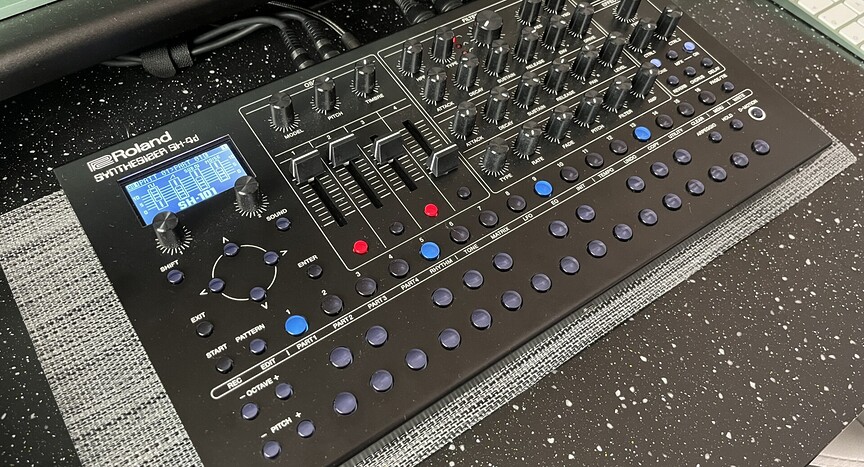I’ve previously owned Roland’s MC-707 and MC-101 grooveboxes, and, while they weren’t bad products, I eventually sold them on. This was primarily due to the amount of menu diving needed to design your own sounds. These two machines are great if you just like to use presets, but for designing your own, I found it too cumbersome to navigate the synth engine using just four control knobs with such a deep menu structure. Roland do offer a VST/AU plug-in that allows you to create patches on your computer, but I much prefer the tactile feel of using real knobs and sliders, and don’t find using a computer to make music inspiring, so this wasn’t an option for me. In comes the Roland SH-4d Desktop Synthesizer…
It seems like Roland really have been listening to their customers. Gone is the ugly plastic casing and bright flashing lights seen on previous AIRA products. The SH-4d has a solid metal housing and just the right amount of knobs and sliders to make sound design a breeze. Here you get direct control over the oscillators, filters, envelopes, LFOs and effects on the front panel (with up to four parameters recordable in real-time (or step-by-step) as motion in your patterns). Roland are also famous for chucking additional parameters in one long cryptic menu. However, on the SH-4d, all additional sound design parameters are quickly accessed by a series of shortcuts all nicely labelled on the front panel. It really is a pleasure to use and it sounds great too!
The Zencore synth engine, while not quite as authentic as Roland’s Analog Circuit Behaviour (ACB) technology, is capable of creating very nice approximations of many of Roland’s classic synths, including the SH-101, JUNO 106, JD-800, JX-8P, Alpha Juno and many more. If I had one criticism, it would be that the SH-4d only has one (multi-mode) filter type. It sounds nice, and includes the usual low pass, band pass and high pass modes, but it would be good if Roland could update it to include the other additional filter model types found in the other Zencore products.
The oscillator models provided are really clever, however the name is a bit misleading. These don’t actually use any component level modelling as seen in their ACB products such as the SH-01A or JU-06A boutiques or the recently announced Compact series (T-8, J-6 and S-1). Instead, the same Zencore oscillators are used in all of the models, with each model just exposing the oscillator parameters relevant to the synth they are trying to emulate. However, don’t let this put you off – It’s actually really useful when you want to quickly dial in an SH-101 bass or some Juno strings, for example. For most sounds though, I tend to use the SH-3d model, which gives you 3-oscillators and an extra LFO for deeper sound design with the included matrix. Talking of which, the matrix is one of the easiest to program that I’ve come across as setting modulation sources and destinations can be done by just choosing a slot and then turning the relevant knobs.
Not so easy though is saving patterns, which is cumbersome to say the least. When saving a pattern the SH-4d requires that you rename and save each and every tone, as well as the rhythm kit, before you can save the pattern. Even without renaming each of them this results in no less than 14 button presses before your pattern can be saved. It’s a real workflow killer. To get around this I have created a backup file with all of the tones and kits pre-named and saved with each pattern. You can download this here for free.
One of the best things about the SH-4d is the included rhythm track. This is PCM based but does also include a number of waveforms so you can synthesise your own drums. You can also layer two waves and cross modulate them which leads to some really nice metallic percussive sounds. Each of the 26 drum sounds also gets its own multi-mode filter, as well as pitch, filter and amp envelope. There are no LFOs or modulations available for the drums however.
The SH-4d has a massive suite of very usable effects including several types of filters, phasers, flangers, chorus, modulation effects, overdrives, distortions, compressors, limiters, delays and reverbs. Every part (including the rhythm track) gets its own Tone effect slot, and, as well as the pattern send FX (Chorus, Delay and Reverb), each pattern has its own Master effect (MFX). One of the issues with using pattern FX, though, is that when you change patterns the effects tails are abruptly cut off. This is a shame because it means you can’t seamlessly transition between different patterns, even if they use the same effects. Probably the reason why Roland never included the ability to chain your patterns as it would have highlighted this issue further.
In summary, the Roland SH-4d is an excellent desktop synthesiser, perfectly suited for use as either a standalone groovebox or a sound module/multitimbral synthesiser in a larger setup. It’s not without its annoyances (mainly the convoluted saving process and pattern changing glitches) but I’d highly recommend it if you’re looking for something with all of the classic Roland sounds in one reasonably priced and easy to use box. It’s highly portable too, and can be powered by either four AA batteries or using a USB power bank, so it’s ideal if you’re looking for something you can use while out and about.
Below are links to a few demo videos I recorded using the Roland SH-4d Desktop Synthesizer.



synthdemic
The pattern saving is a real pain. They really need to fix that.